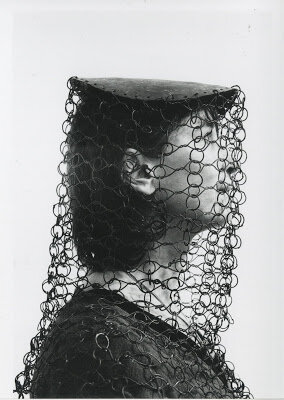Interview with Victoria Rance
I interview Victoria Rance to explore mutual themes and materiality across our chainmail works and discussing the effects of lockdown.
Left: Her Skin. Victoria Rance. 2008.
iron and steel
170 x 65 x 40 cm
(hand printed black and white photograph)
To see more of Rance’s work visit her website: www.victoriarance.com
How has the lockdown affected the way you are working logistically?
I haven’t been working in my studio since end of March, the longest I’ve ever been away I think, except for when my studio flooded. That changed my working methods too. This time though I got ill with COVID19 and was in bed for weeks. I started drawing my family in bed, then got really sick and could do nothing, then as I recovered I began creating little animations from felt figures I was making. I had started making these little figures pre lockdown in the studio (originally for comforting a friend with a broken heart) and brought back a shoe box of sewing things and felt. For weeks this shoe box was my studio. The animations were all made in this box, starting with one character, and making a world for her. Gradually I have been working both in another room in the house and outdoors. I could go to my studio now but want to finish this project. It suits the flexibility I need with other demands at home, being interrupted by family, and it’s easy to carry about. My son has been with me a lot and helping, discussing, he’s been making films too and it’s been good for both of us.
Do you feel that you have gained anything creatively from the effects of the lockdown?
My teenage son has been with me a lot and helping, discussing, he’s been making films too and it’s been good for both of us. I have loved the ability to focus, especially before I went back to teaching online. All I had to do was get well and make art. And I gave myself a theme to properly explore, and had delivery of a big and complex book. I wouldn’t normally have had the time and ability to focus and read every word, often several times, which I did. And that was very special. I decided to embrace the outsider-ness of working from home. Not having the same aesthetics or production standards as in the studio, but enjoying rapid, amateur (from love), childish production as I did when a child. It brought back so many memories of when my bed was my world, of being ill, in hospital, and childhood toys and fabrics and fantasies.
My chainmail works combine a masculine materiality into lace-like patterns associated with femininity. This expresses the complexities of gender identity and challenges the notion that they are simply binary. Your works Her Skin and Mantilla both create a kind of chainmail armour from wire eyes. Could you explain why you have included the eye symbol and what significance the use of metal has in your work?
Mantilla. Victoria Rance. 2008
silicone bronze and steel
36 x 21 x 34 cm
C-type photograph with Clare Whistler 2010
In my work, I consider armour to be a symbol of bravery but also the sign of a vulnerability in need of protection. Your works cover the whole body and offer protection, but also a place to choose to hide. I often feel conflicted about simply expressing the vulnerability I experience as a woman and I feel it is important to promote the image of an empowered woman with equal emphasis. Do you also experience this conflict and how do you reconcile it in your work?
As I said above ambivalence is an important quality in my thinking and work. The ego interests me. When people have crises, tragedies, mental illness or breakdowns they can lose their ego strength. “Egotistical” is an insult, so is “narcissistic”, but there is a need for a degree of egotism and a healthy narcissism. The ego needs developing in childhood and protecting. In women it is often squashed by upbringing and culture in every aspect of life. To imagine being strong and armoured helps. And vulnerability is an aspect of life for men and women. How to be empowered, strong, confident while keeping the openness and sensitivity needed to be a successful artist (or human being)? The open armour, chain mail with its incredible softness and flexibility perhaps can symbolise this.
The eye is about seeing and being seen, paranoia about being looked at, while also looking out. The wearers are ultra aware, ultra vulnerable, but also protected. Those works are full of ambivalence. And about the ego, its necessity. It is also a reference to the “evil eye” and protection. The “nazar” or evil eye wards off envy, and is displayed in the Middle East when a special event like a wedding, birth or exhibition happens. There 21 is a recognition, which we lack in European culture, of the existence and harm done by envy. Recognising it, saying “yes this amazing thing has happened to me, you will feel envious, I am protecting myself from it by recognising it” helps. By looking at it squarely. Metal has a history as you recognise, of armour and protection. When I use it I am referencing its history for armour, and protection, and its immense decorative qualities and the skills associated with it. Metal work technology has changed human development, culture and history. My sculpture SOS particularly references Islamic armour I saw in The Metropolitan Museum New York which has the names of Allah on every piece of chain. It is protective both physically and as a talismanic object.



